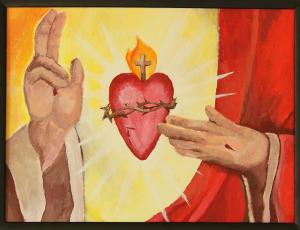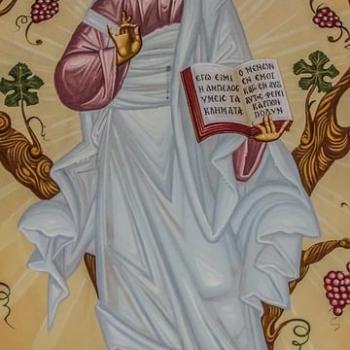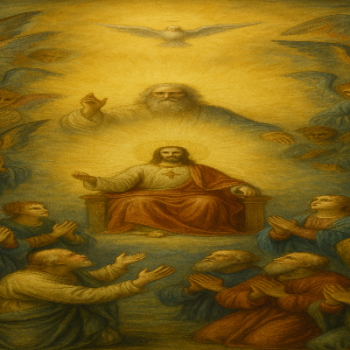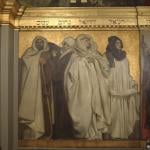
“The prayer of the Church venerates and honors the Heart of Jesus just as it invokes his most holy name. It adores the incarnate Word and his Heart which, out of love for men, he allowed to be pierced by our sins.” – Catechism of the Catholic Church, Paragraph 2669.
In December of 1673, a French nun named Sister Margaret Mary Alacoque started to experience visions that included communicating with Christ. During one of these encounters, Jesus instructed Sister Alacoque. “I ask of you that the Friday after the octave of Corpus Christi be set apart for a special feast to honor my Heart, by communicating on that day, and making reparation to it by a solemn act, in order to make amends for the indignities which it has received during the time it has been exposed on the altars. I promise you that my Heart shall expand itself to shed in abundance the influence of its divine love upon those who shall thus honor it, and cause it to be honored.”
So began a lengthy journey that would culminate in Pope Pius IX designating the Friday following the feast of Corpus Christi as the feast of the Sacred Heart for the universal Church. Since that time, the month of June has been devoted to the Sacred Heart of Jesus.
In this paper, I will discuss the symbolism of the heart in history and in Catholicism. I will examine what is meant by the Sacred Heart of Jesus and the Immaculate Heart of Mary. Finally, I will explore the importance of devotion to the Sacred Heart.
The Heart In History
Using the heart as symbolism appears to be as old as mankind itself. There is evidence of Cro-Magnon hunters in Europe using the symbol in cave pictograms some 10,000 years ago.
The ancient Egyptians believed that the heart was the center of the moral life. Similarly, the ancient Greeks thought the heart was the center of the soul. While much of what the Romans believed about the heart was medically incorrect, they accurately described valves and ventricles and the differences between veins and arteries.
Of course, from Catholicism’s perspective, the term heart is intended symbolically to refer to the seat of emotion and morality. Using the heart as a symbol of emotion and morality provides a point of departure for understanding the Sacred Heart of Jesus.
The Sacred Heart
The heart provides the symbolism necessary to connect the human concept of love with the Divine love of God. Therefore, to speak of the Sacred Heart of Jesus is to speak of the divine love he shares with the Father and the Holy Spirit. This love is then manifested in the incarnate God “In Him dwells the fullness of the Godhead bodily” (Colossians 2:9). (See Pope Pius XII, Haurietis Aquas).
Significantly, Catholicism asserts that the sacred Heart of Jesus allows us to identify the three-fold love of God. In the first instance, the Sacred Heart reveals the Trinitarian love; the shared love between God the Father, God the Son, and God the Holy Spirit.
In the second instance, there is also the love that Christ, as both God and man, has for us. This Divine love has immense significance to our salvation. It is out of the abundance of God’s love and mercy that “He gave His only Son, so that everyone who believes in him might not perish but might have eternal life.” (See John 3:16).
Finally, there is the sensible love of Jesus. This aspect of the three-fold love is the most relatable for its humanity since it most closely resembles human love. It is best summed up in Jesus’ reaction to the death of His friend Lazarus. “Jesus wept.” (John 11:35).
The heart’s symbolic significance in Catholicism also extends to Mary, although it does so in a different manner. Where the Sacred Heart refers to the love of God, the use of the heart vis-a-vis the Blessed Virgin Mary is intended as a sign and symbol of her compassion and sinlessness. Devotion to the Immaculate Heart of Mary gained international prominence through the Fátima apparitions in 1917 and their subsequent approval by the Holy See. Devotions to the Immaculate Heart remain a significant object of practice by the Catholic faithful.
The Liturgical Significance Of The Sacred Heart
While the feast of the Sacred Heart is relatively recent, devotions to the Sacred Heart are found much earlier. Many Church fathers, including Origen, Saint Jerome, Saint Augustine of Hippo, Saint Irenaeus, Saint Justin Martyr, and Saint Cyprian, practiced various devotions to the Sacred Heart.
In the 11th century, devotions to the Sacred Heart were renewed in the writings of Benedictine and by the work conducted in Cistercian monasteries. Saint Bonaventure’s work “With You is the Source of Life” remains part of the Divine Office on the Solemnity of the Sacred Heart.
The various devotions can take the form of prayers, offerings, and novenas. The prayers are traditional in the form that they take, to wit, adoration, confession, and supplication. Offerings to the Sacred Heart seek to unite the individual to God by offering to God whatever works and sufferings one experiences. This is often done for the reparation of sins. Novenas are a set of prayers recited for nine consecutive days. Novenas are frequently used for a specific intention or grace and may be directed to particular saints for their intercession.
Finally, for those who maintain a devotion to the Sacred Heart, Jesus makes twelve promises. (Per Saint Margaret Mary Alacoque).
(1) “I will give them all the graces necessary in their state of life.
(2) I will establish peace in their homes.
(3) I will comfort them in all their afflictions.
(4) I will be their secure refuge during life, and above all, in death.
(5) I will bestow abundant blessings upon all their undertakings.
(6) Sinners will find the source and infinite ocean of mercy in my Heart.
(7) Lukewarm souls shall become fervent.
(8) Fervent souls shall quickly mount to high perfection.
(9) I will bless every place where an image of my Heart is exposed and honored.
10) I will give priests the gift of touching the most hardened hearts.
(11) Those who promote this devotion shall have their names written in my Heart.
(12) I promise you in the excessive mercy of my Heart that my all-powerful love will grant to all those who receive Holy Communion on the First Fridays in nine consecutive months the grace of final perseverance; they shall not die in my disgrace, nor without receiving their sacraments. My divine Heart shall be their safe refuge in this last moment.”
Conclusion
Scripture tells us that God is love (1 John 4:16), and what better symbol for that love than the Heart of Jesus?
In this paper, I have endeavored to explain the symbolism of the heart and the origins of the various devotions to the Sacred Heart and the Blessed Virgin Mary. Finally, I have delineated the twelve promises of Christ to those who devote themselves to the Sacred Heart of Jesus.













